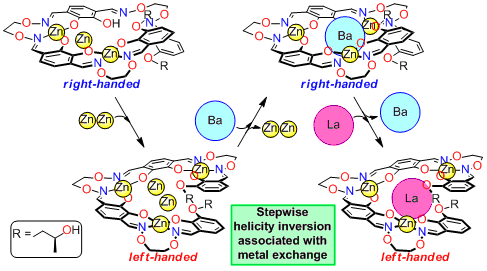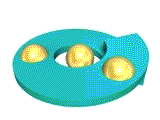RESEARCH TOPICS
Inverting helical structures:
-- Multistep helix inversion by sequential metal exchange
Helicity inversion, which converts the right-handed form into the left-handed one and vice versa, is useful to invert chiral functions of the helical molecules. To date, various kinds of mechanisms for helicity inversion including our molecular leverage system have been developed. However, most of the reported helicity inversions are based on a single-mode transition, i.e., the conversion between right- and left-handed states. If a sequential and multistep conversion feature is incorporated into the helicity inversion system, it would work as a multifunction control system that can switch different kinds of asymmetric functions upon each helicity inversion.

However, it is not so easy to achieve multistep conversion. We need to introduce responsive moieties for each step of the multistep conversion, often leading to too complicated structures that are difficult to be synthesized. To incorporate such a multi-sequential conversion feature into a functional molecular system, metal coordination has a great advantage: we can convert one state to another simply by changing the metal ions based on labile coordination bonds. Thus, we set out to develop a new helicity inversion system that allows the stepwise multi-sequential helicity inversion utilizing metal exchange of helical complexes derived from a linear hexaoxime ligand.

For the purpose of the multistep helicity inversion, an oligooxime ligand having (S)-2-hydroxypropyl groups as a chiral auxiliary worked nicely. Upon addition of 3 equiv of zinc(II) acetate, the ligand was converted into a trinuclear complex LZn3 having a right-handed helical structure. Further addition of 2 equiv of zinc(II) acetate afforded a pentanuclear complex LZn5 having a left-handed helical structure. This complex was then converted into right-handed LZn3Ba complex upon the addition of Ba2+. Upon addition of La3+ to LZn3Ba, the Ba2+ was replaced with a La3+ to give LZn3La with a left-handed helical structure.

We have already reported the affinity order of Zn2+ < Ba2+ < La3+ in the central binding site surrounded by phenoxo oxygen atoms for related oligooxime ligands. The metal-binding with this affinity order was successfully employed to the multistep helicity inversion system in this study.

[Hover to animate]
[Reference]
“Stepwise Helicity Inversions by Multisequential Metal Exchange”
Akine, S.; Sairenji, S.; Taniguchi, T.; Nabeshima, T.
J. Am. Chem. Soc. 2013, 135, 12948-12951.
doi:10.1021/ja405979v

